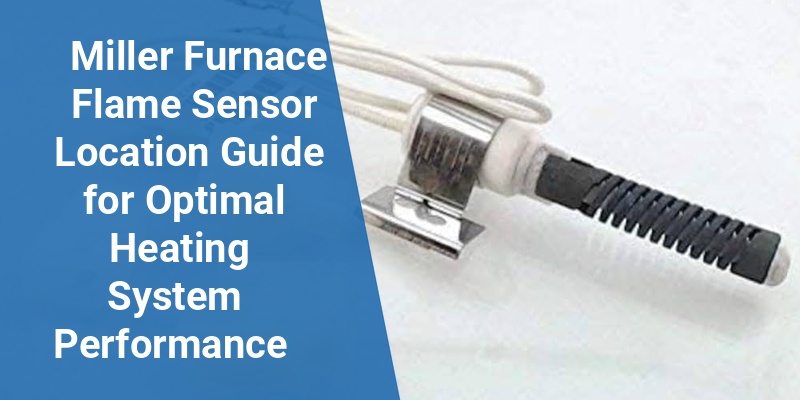Locating the flame sensor in a Miller furnace is essential for maintaining efficient and safe heating system operations. The flame sensor detects the presence of a flame inside the furnace to ensure proper combustion, preventing gas leaks and system malfunctions. This guide provides detailed information on the typical placement of the flame sensor, its role, and maintenance tips to help homeowners and HVAC technicians troubleshoot and optimize their Miller furnace performance effectively.
| Component | Purpose | Common Location |
|---|---|---|
| Flame Sensor | Detects flame presence to ensure safe ignition | Near the burner assembly inside the burner box |
| Burner Assembly | Mixes fuel and air to create a controlled flame | Inside the furnace combustion chamber |
| Ignitor | Ignites the gas to start the flame | Close to flame sensor and burners |
Where Is the Flame Sensor Located in a Miller Furnace?
The flame sensor in a Miller furnace is typically located near the burner assembly inside the combustion chamber. It is a thin metal rod positioned so that it can accurately detect the presence of a flame during the ignition cycle. This placement is crucial because it allows the sensor to confirm that the gas has successfully ignited, enabling the furnace to continue normal operation.
In most Miller furnace models, the flame sensor is mounted either on the side or front edge of the burner box, inserted directly into the flame path. You will often find it near the ignitor, which lights the gas.
The Role of the Flame Sensor in Miller Furnaces
The flame sensor’s core function is to monitor the combustion process. This sensor acts as a safety device that ensures the furnace’s gas valve closes if no flame is detected, preventing gas buildup. Without a properly functioning flame sensor, the furnace may shut down frequently or fail to ignite altogether.
By providing constant flame detection, the sensor helps maintain safe and efficient furnace operation. Regular flame sensor checks are vital for avoiding costly repairs or dangerous gas leaks.
How to Identify the Flame Sensor in Your Miller Furnace
- Appearance: Usually a slim, metal rod about 4-6 inches long with a ceramic or insulated base.
- Connection: One or two thin wires connect the sensor to the control board to send signals.
- Placement: Found inside the burner compartment close to the ignition source and the burners.
Consult the furnace’s user manual or schematic, which often includes a diagram showing the exact flame sensor location for your specific Miller model.
Common Miller Furnace Models and Typical Flame Sensor Locations
| Miller Furnace Model | Flame Sensor Location Description |
|---|---|
| Miller M2GA Series | Near the right side burner, behind the burner box access panel. |
| Miller MGH Series | Mounted at the top front of the burner assembly inside combustion chamber. |
| Miller MKB Series | On the left side of the burner box, aligned with the main burners. |
Signs of Flame Sensor Problems in Miller Furnaces
A malfunctioning flame sensor often causes furnace operation issues. Common symptoms include:
Call 888-906-9139 for Free Local HVAC Quotes – No Obligation, Just Savings!
- Furnace shutting off shortly after ignition.
- Intermittent heating cycles.
- Pilot light or burner failing to stay lit.
- Error codes indicating ignition failure on the control board.
Detecting these signs early allows for timely sensor inspection and replacement if necessary, avoiding furnace downtime.
How to Clean and Maintain the Flame Sensor
Flame sensors can accumulate soot or dirt, which impairs their function. Proper routine maintenance entails:
- Turning off the furnace and disconnecting power for safety.
- Locating the flame sensor inside the burner compartment.
- Removing the sensor by unscrewing its mounting screw.
- Cleaning the sensor rod with fine-grit sandpaper or steel wool to remove build-up.
- Wiping with a clean cloth to remove debris.
- Reinstalling the sensor and restoring power to test furnace operation.
Regular cleaning every heating season can prevent sensor-related ignition problems and improve furnace reliability.
When to Replace the Flame Sensor
Flame sensors generally last several years but may fail due to corrosion or physical damage. Consider replacement if:
- Cleaning does not resolve ignition issues.
- The sensor appears visibly damaged or corroded.
- The furnace control board still reports flame failure despite a clean sensor.
Replacing the flame sensor is typically an affordable, straightforward task that restores furnace safety and performance.
Professional Assistance for Flame Sensor Issues
If locating or servicing the flame sensor is challenging, consult a certified HVAC technician. Professionals have the expertise and tools to:
- Correctly identify the flame sensor location specific to the Miller furnace model.
- Safely perform removal, cleaning, or replacement.
- Run diagnostic tests to ensure all furnace components function optimally.
Professional maintenance safeguards system longevity and helps avoid costly furnace breakdowns.
Call 888-906-9139 for Free Local HVAC Quotes – No Obligation, Just Savings!
